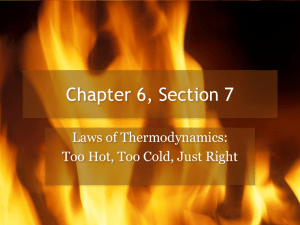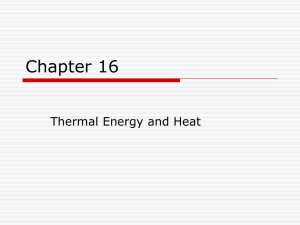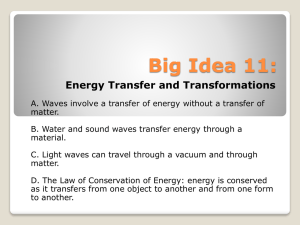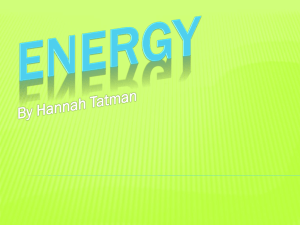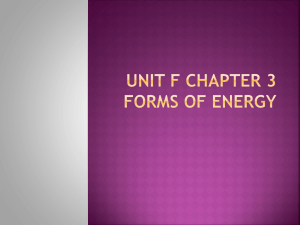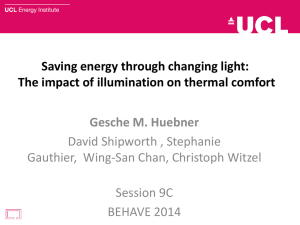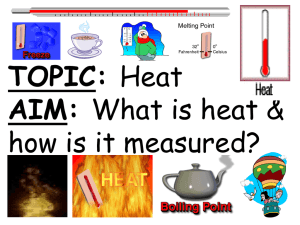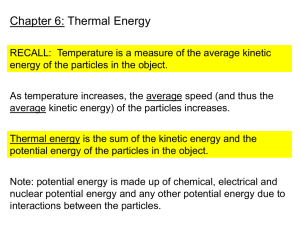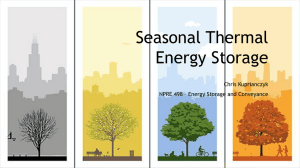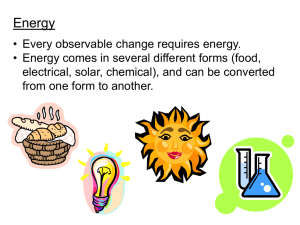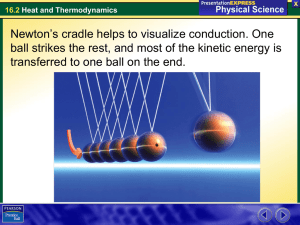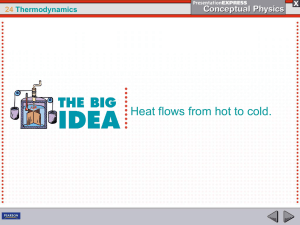Energy Work and Power
advertisement
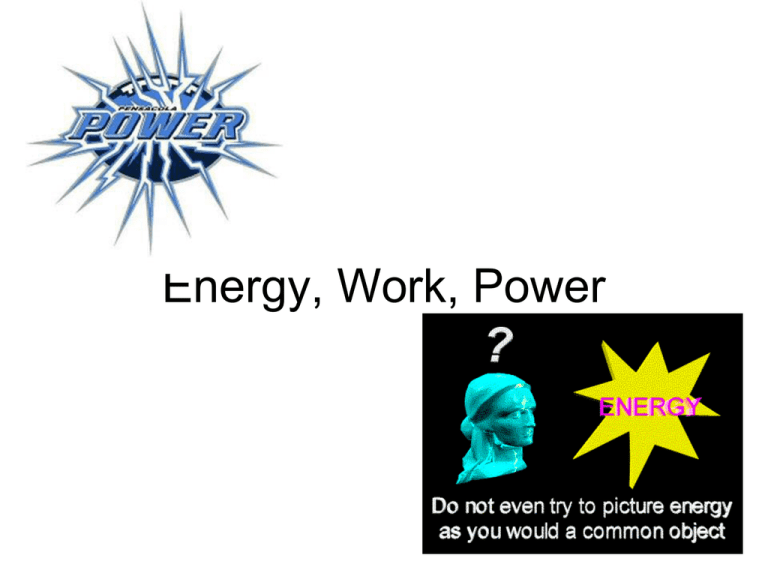
Energy, Work, Power ENERGY -The ability to cause CHANGE -Anything that causes change must have ENERGY!! -You use energy to function Different Forms of Energy 1. Electrical 2. Chemical 3. Radiant 4. Thermal These are like different forms of money KINETIC ENERGY (KE) -The energy of MOTION -All moving objects have Kinetic Energy! -Depends on: MASS and SPEED of the object -Equation: Kinetic Energy (KE) Joules = 1/2mass(kg) X speed2 KE = 1/2mv2 -Joule (J) = SI unit for Energy Example Problem with Kinetic Energy -A jogger whose mass is 60kg is moving at a speed of 3 m/s. What is the jogger’s Kinetic Energy? Mass = 60kg Velocity = 3 m/s KE = ??J KE = 1/2mv2 KE = 1/2(60kg)(3m/s)2 KE = 270 J POTENTIAL ENERGY (PE) -The energy of REST -Objects at REST have POTENTIAL ENERGY -Potential Energy is CHANGED into KINETIC ENERGY when MOTION occurs TYPES OF POTENTIAL ENERGY 1. Elastic Potential Energy = Energy stored by something that can be STRETCHED or COMPRESSED Ex: Rubber band 2. Chemical Potential Energy = Energy stored in CHEMICAL BONDS Ex: Food, Natural gas 3. Electrical Potential Energy = Energy stored due to ELECTRICAL CHARGES 4. Nuclear Potential Energy = Energy stored in the NUCLEI OF ATOMS TYPES OF POTENTIAL ENERGY 5. Gravitational Potential Energy: Energy stored by objects due to their POSTION ABOVE EARTH -Ex: Anything with the potential to FALL -Depends on: MASS and HEIGHT above ground -Equation: GPE (J) = Mass (kg) X gravity (m/s2) X height (m) GPE = mgh Remember: Gravity on Earth = 9.8 m/s2 GPE Example Problem -What is the GPE of a ceiling fan that has a mass of 7kg and is 4m above the ground? GPE = mgh Gravity = 9.8 m/s2 Mass = 7 kg Height = 4 m GPE = (7kg)(9.8m/s2)(4m) = 274 kgm2/s2 = 274 J To INCREASE GPE 1: INCREASE object’s HEIGHT 2. INCREASE object’s MASS 7KG 2KG 2KG 2KG The Change of GPE to KE -As objects fall, GPE is changed into KE -KE is LARGEST right before the object hits the ground, thus GPE is the SMALLEST right before hitting the ground -Objects with MORE GPE move FASTER because they have more KE Converting between KE and PE -MECHANICAL ENERGY = Total amount of POTENTIAL and KINETIC energy in a system Mechanical energy = PE + KE What happens to the mechanical energy as PE and KE are converted into each other? ME stays the same!! As PE and KE are converted, the FORM of energy changes, but the TOTAL AMOUNT STAYS THE SAME The Law of Conservation of Energy -States that: ENERGY CAN’T BE CREATED OR DESTROYED!! -So does this mean the total amount of energy in the Universe is the same at all times??? Friction and Air Resistance These forces can cause some mechanical energy to change into THERMAL ENERGY!! TEMPERATURE -TEMPERATURE = Measure of the AVERAGE KINETIC ENERGY of the particles in an object -As temp. INCREASES = Average SPEED of particles INCREASE = KE INCREASES -SI UNIT: Kelvin (K) or Celsius (0C) THERMAL ENERGY Sum of the KINETIC and POTENTIAL energy of all the particles in an object THERMAL ENERGY & TEMPERATURE -As KE INCREASES = TEMPERATURE INCREASES THUS -As TEMP INCREASES = THERMAL ENERGY INCREASES THERMAL ENERGY & MASS -As MASS INCREASES = total KE INCREASES THUS -AS MASS INCREASES = THERMAL ENERGY INCREASES HEAT -Thermal energy that FLOWS from something at a HIGHER TEMP to something at a LOWER TEMP -Form of ENERGY -Measured in JOULES (J) ***Always flows from warmer to cooler*** SPECIFIC HEAT -Amount of HEAT needed to RAISE THE TEMP of 1kg of a material by 10C -Measured in: J/(kg 0C) -As a substance absorbs HEAT, its TEMP change depends on the composition of the substance. This is called the Specific Heat of the substance! Ocean water v/s Beach Sand (see next slide) SPECIFIC HEAT EXAMPLE PROBLEM 1 kg of sand takes 6x less heat to raise it 10C than 1 kg of water Which has the higher specific heat?? WATER Which can absorb more heat with changing its temp? WATER TRANSFERRING THERMAL ENERGY -3 Ways to transfer thermal energy from place to place 1. CONDUCTION 2. CONVECTION 3. RADIATION CONDUCTION -The transfer of energy by COLLISIONS or TOUCH -This happens because particles are in CONSTANT MOTION -Thermal Energy is transferred by collisions between molecules with more KE to molecules with less KE **HEAT is transferred by COLLISIONS, not by movement of matter** HEAT CONDUCTORS 1. Heat moves faster by conduction in SOLIDS and LIQUIDS than in gases Gases are more WHY?? spread out/collisions are less frequent 2. The BEST conductors = METALS WHY?? All the e – aren’t bonded to atoms, so they move more freely CONVECTION -The transfer of thermal energy in a FLUID (gas or liquid) by movement of WARMER and COOLER fluid from place to place -Uses CONVECTION CURRENTS to transfer the energy from WARM TO COOL -Still uses collisions to transfer as well -As a fluid increases its temp = it EXPANDS and its DENSITY DECREASES WHY?? -Particles have more KE = move faster = spread out RADIATION -The transfer of energy by ELECTROMAGNETIC WAVES -Waves can travel through space even though there is no matter THUS Radiation is the only form of energy transfer in space -Energy = RADIENT ENERGY RADIATION -Radiation can be ABSORBED, REFLECTED, or TRANSMITTED thru an object -This depends on: MATERIAL OF OBJECT -LIGH-COLORED = Reflect more -DARK-COLORED = Absorb more -Radiation can be TRANSMITTED thru: 1. SOLIDS 2. LIQUIDS 3. GASES INSULATORS -A material in which HEAT FLOWS SLOWLY -Good Conductors = BAD INSULATORS -Good Insulators = Wood, plastic, fiberglass, air -Gases are usually the BEST INSULATORS CONTROLLING HEAT FLOW -You can use various materials to control heat flow Ex: Jacket/sweater -Living organisms have special features to help control the flow of heat Ex: Fur, Blubber, Scales (reflect), Color Transferring Energy Review: 1st: Discussed transferring energy as HEAT -Heat flows from an object that is warmer (more ke) to an object that is cooler (less ke) New Stuff: 2nd way to transfer energy -Work = transfer of energy that occurs when a force makes an object move WORK RECALL: Force = push or pull - In order for WORK to be done, a FORCE must make something MOVE. -So: If you push your hand straight down on the table right now (apply a force) and the table doesn’t move, have you really done any work?? Doing Work Two Things are Required for Work to be done: - The force must make object move - Movement must be in the same direction as the force Force is Up, Movement is Up Work and Energy Another way to think about energy is: -ENERGY is the ability to do WORK -If something has energy, it can transfer it to another object by doing work on that object. -When you do WORK on something, you INCREASE its ENERGY -Energy is always transferred from the object doing work to the object on which work is done. CALCULATING WORK Amount of Work done depends on: 1. Amount of Force used 2. Distance over which force was applied (distance the object moves) Work (in joules) = applied force (newtons) X distance (meters) W = Fd Example Problem You push a refrigerator with a force of 100 N. If you move the refrigerator a distance of 5 m, how much work do you do? F= 100 N d=5m W = ?? W= Fd W = (100N)(5m) W = 500Nm W = 500 J POWER = The amount of work done in one second/the RATE at which WORK is done For example: If you and a friend push two boxes (identical in mass) for the same distance = YOUR WORK DONE IS EQUAL BUT: If your friend pushes the box faster than you, your friend is MORE POWERFUL! CALCULATING POWER Power (in watts) = Work (in Joules) time (in seconds) P=W t SI Unit for Power = Watt (W) 1 Watt = 1 J of work done in 1 sec (small unit) Use kilowatt (kW) to often express power 1 kW = 1000 W Example Problem You do 900 J of work in pushing a sofa. If it took 5 sec to move the sofa, what was your power? W = 900 J t = 5 sec P = ??Watt P = W = 900 = 180 J/s = 180 Watts t 5 Power and Energy Power is also the RATE at which ENERGY is TRANSFERRED Power (in Watts) = energy transferred (in joules) time (in seconds) P=E t Ex: A light-bulb transfers electrical energy into light and heat. Calculating Changes in Thermal Energy Changes in thermal energy (J) = Mass (kg) X change in temp. (oC) X specific heat (J/kg oC) Q = m (Tf-Ti) C Example: Find the change in thermal energy of a 20-kg wooden chair that warms from 15oC to 25oC if the specific heat is 700 J/(kg oC) Q = 20(25-15)(700) = Mass = m=20kg Ti = 15 oC Tf = 25 oC Specific heat = C= 700 J/(kgoC) 20(10)(700) = 140,000 J THERMODYNAMICS There is another way to increase thermal energy besides adding heat Thermodynamics = The study of the relationship between thermal energy, heat, and work. System = Anything you can draw a boundary around. Heat transferred to a system is the amount of heat flowing into the system across that boundary. First Relationship: Heat and Work both increase Thermal Energy Ex. Situation 1: Sitting by a fire, you warm your 2 warms your hands by holding them closeSituation to the fire. hands up more! Situation 2: Sitting by a fire, you warm your hands by holding them close to the fire and rubbing them together Open System = Thermal energy of this system can change Closed System = processes can happen within the system/but no energy is entering or leaving = Thermal Energy of this system doesn’t change THERMODYNAMICS First Law of Thermodynamics States: The INCREASE in THERMAL ENERGY of a system = the WORK DONE plus the HEAT TRANSFERRED to the system or The increase in energy of a system = the energy added to the system 90 J of energy added to the system Increase of 90 J within the system 1st law explains the following: -When Heat flows from a warm object to a cool object, the Thermal Energy of the Warm object decreases = the Increase in Thermal Energy of the Cool Object So: Can heat flow spontaneously from a cool object to a warm object?? THERMODYNAMICS Second Law of Thermodynamics: It is IMPOSSIBLE for HEAT to FLOW from a COLD OBJECT to a WARM OBJECT unless WORK IS DONE Also explains that it is impossible to build a device that is 100% efficient Friction between objects can completely convert work into heat. -Is it possible to completely convert heat into work? 2nd Law of Thermodynamics FORBIDS this from happening. 2nd Law makes it IMPOSSIBLE to build a device that converts heat completely into work! HEAT ENGINE: A device that converts heat into work. Ex: Car’s Engine - converts chemical energy (gas) into heat, then transfers some of the thermal enegy into work by rotating the wheels. Only 25% of the heat is converted to work. Where does the rest go??

